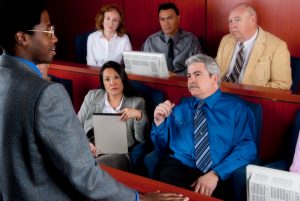Browsing the Complexities of Test Presentations: Tips for Seamless Distribution and Compelling Disagreements
In the realm of legal process, the art of trial discussion stands as a crucial factor of success. The intricacies inherent in test discussions require a delicate balance of skill, strategy, and skill.

Comprehending Trial Purposes
To properly navigate a trial, it is critical to have a clear understanding of the goals that require to be achieved. Before entering the court, lawful teams must define their goals and preferred end results. These objectives serve as leading principles throughout the trial, shaping approaches and affecting decision-making processes.
Recognizing trial purposes involves a comprehensive analysis of the instance, lawful precedents, and the client's finest interests. Trial Presentations. It requires a precise assessment of the realities, recognizing key issues, and expecting prospective obstacles. By establishing quantifiable and particular goals, lawyers can tailor their disagreements and discussions to align with the preferred outcomes
In addition, a clear grasp of test objectives allows lawful groups to focus on evidence, witnesses, and legal debates effectively. It permits the growth of a meaningful story that reverberates with the court and court, reinforcing the general case presentation.

Organizing Evidence Efficiently
Having a clear understanding of trial goals lays the structure for organizing proof successfully in lawful procedures. By aligning the discussion of evidence with the desired end results of the trial, lawful teams can enhance their debates and improve their persuasiveness.
An additional crucial element in arranging proof efficiently is developing a rational flow. Offering evidence in a systematic and consecutive way can aid construct a compelling narrative that supports the legal arguments being made. Furthermore, making use of visual help such as graphes, timelines, or graphs can further boost the company of proof and aid in making clear complicated partnerships or sequences of occasions.
In addition, making sure that all proof offered is pertinent and acceptable to the situation is necessary. Inadmissible or unimportant proof can interfere with the stamina of the disagreement and possibly hurt the trustworthiness of the here and now event. Therefore, a precise evaluation and choice process ought to be carried out to include just one of the most lawfully sound and impactful evidence in the test discussion.
Crafting Influential Narratives
Crafting engaging stories plays a crucial duty in presenting persuasive debates during legal procedures. When creating a narrative for a test discussion, it is necessary to develop a clear story that highlights key points and connects them in a systematic manner. By weaving read here together proof, testament, and legal arguments right into a influential and cohesive narrative, lawful specialists can effectively promote for their clients and boost the chance of a positive result in the courtroom.
Mastering Visual Help
Efficient use visual aids is crucial to improving the effect and clearness of trial presentations. Aesthetic help, when used strategically, have the power to streamline complicated details, strengthen bottom lines, and leave a long-term impression on the discretionary. To grasp aesthetic help in trial discussions, it is critical to ensure that they are clear, succinct, and pertinent to the debates being made.
When integrating visual help, such as graphes, pictures, timelines, or charts, right into a trial discussion, it is important to maintain them visually appealing yet expert. The visuals ought to complement the verbal arguments, providing an aesthetic representation of the details being reviewed without overwhelming the audience with unneeded information.
In addition, exercising with the aesthetic aids in advance is necessary to guarantee a smooth distribution during the test. Familiarizing oneself with the material, changes, and timings of each aesthetic aid can assist maintain the flow of the presentation and protect against technical glitches that may arise.
Providing Impactful Closing Debates
An engaging closing argument serves as the end result of a test discussion, encapsulating the core story and convincing the discretionary in the direction of a favorable choice. To provide an impactful closing disagreement, it is critical to succinctly evaluate bottom lines, highlight the strengths of resource your case, and attend to any kind of weak points in a tactical way. Begin by outlining the primary disagreements that support your client's position, highlighting why the evidence provided throughout the test supports your story. It is vital to develop a feeling of cohesion and clearness, guiding the discretionary towards the preferred conclusion.
In addition, integrating sob story can additionally reinforce your closing argument. By linking and humanizing the situation on an individual level with the decision-makers, you can evoke empathy and understanding, influencing their perception of the realities presented. Furthermore, restating the legal standards that need to be fulfilled for a beneficial ruling can strengthen the validity of your setting. Inevitably, a well-crafted closing debate must leave a long-term perception, compelling the discretionary to rule in your customer's support.
Final Thought
To conclude, understanding test presentations includes comprehending purposes, organizing hop over to here evidence, crafting narratives, utilizing visual help, and delivering impactful closing arguments. By implementing these techniques successfully, legal representatives can present their situation seamlessly and make compelling disagreements in the courtroom. It is critical to navigate the complexities of trial discussions with accuracy and ability to attain success in lawful proceedings.
By lining up the presentation of proof with the desired results of the trial, lawful groups can enhance their debates and enhance their persuasiveness (Trial Presentations). To grasp aesthetic aids in trial presentations, it is critical to make certain that they are clear, succinct, and pertinent to the debates being made
An engaging closing debate offers as the end result of a test presentation, encapsulating the core story and persuading the court and court towards a desirable decision. Begin by describing the major disagreements that sustain your client's setting, highlighting why the evidence presented throughout the trial sustains your narrative.In final thought, mastering test discussions entails recognizing purposes, arranging evidence, crafting stories, using visual help, and supplying impactful closing arguments.